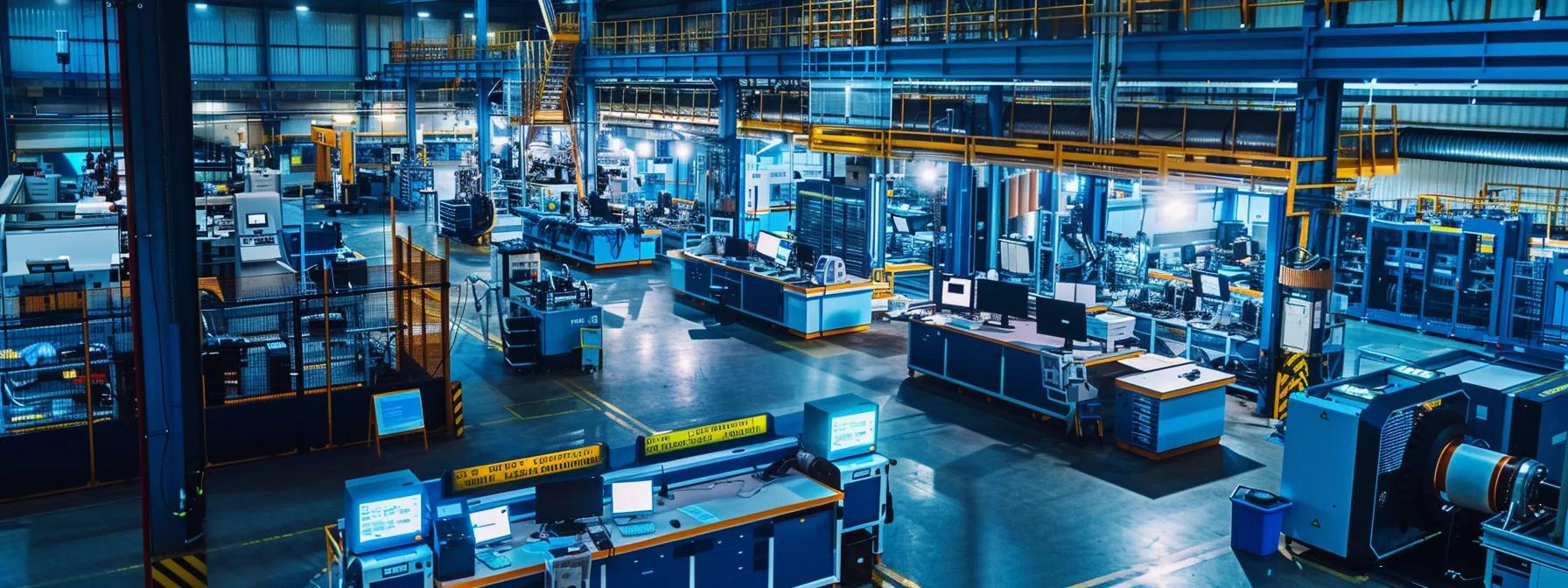Table Of Contents:
- Precision Metal Parts Quality Control Standards In China Explained
- What Is Quality Control in Precision Metal Parts Manufacturing?
- Which Quality Control Methods Are Essential for Precision Metal Parts?
- What Industry Standards Govern Quality Control for Precision Metal Parts?
- How Are Quality Control Processes Integrated Into Manufacturing Methods?
- What Are the Key Benefits of Implementing Quality Control Standards?
- How Does Traceability and Documentation Support Quality Control?
- What Are Emerging Trends and Technologies in Quality Control for Precision Metal Parts?
- Frequently Asked Questions
- Final Thoughts
Precision Metal Parts Quality Control Standards In China Explained
In the competitive realm of precision metal parts manufacturing in China, stringent quality control is not just an operational necessity—it is a strategic imperative. Quality control ensures every component meets exact tolerances, functions reliably, and adheres to industry standards. With increasing pressures from sectors such as aerospace, automotive, medical, and robotics, robust quality control systems are vital. This article examines the processes, methods, and standards involved in quality control for precision metal parts in China, offering actionable insights to improve manufacturing reliability.
What Is Quality Control in Precision Metal Parts Manufacturing?
Quality control in precision metal parts manufacturing in China is the systematic process of verifying that every component meets required design specifications and industry standards. It combines automated and manual inspections to ensure exact tolerances, dimensional stability, and structural integrity for applications ranging from aerospace to medical devices.
How Does Quality Control Ensure Precision and Reliability?
Quality control process in China ensures precision and reliability by using static and dynamic measurement tools. Techniques such as caliper measurements, laser scanning, and coordinate measuring machine (CMM) inspections verify dimensional accuracy. Statistical process control (SPC) continuously monitors production data to detect deviations early and prompt corrective measures, ensuring consistent output and high process reliability.
What Are the Key Quality Control Methods Used?
Variety of quality control methods used by Chinese companies help ensure rigorous standards are met. Visual inspections detect surface imperfections and misalignments, while non-destructive testing (NDT) methods, including ultrasonic testing, radiography, and magnetic particle inspection, evaluate internal and surface defects. Additionally, advanced automation with sensor technology and numerical control programming, along with auditing and first article inspections, work together to deliver consistent, high-quality products.
Why Is Quality Control Critical for Precision Metal Parts?
Quality control is critical because it directly impacts product performance, safety, and cost-efficiency. Inaccuracies can lead to failures under stress, costly recalls, and damage to reputation. Robust quality control minimizes rework and scrap by detecting issues early. In regulated sectors such as medical devices, it is essential for compliance and patient safety.
RELATED ARTICLE: Understanding Cost Influences in Metal Parts Quality Control
Which Quality Control Methods Are Essential for Precision Metal Parts?

Ensuring the integrity of precision metal parts requires a mix of traditional and advanced inspection techniques. These methods provide a comprehensive view of product quality by working together to catch defects at various stages of production.
How Does Statistical Process Control (SPC) Improve Manufacturing Accuracy?
SPC uses statistical methods to monitor and control production in real time. By continually collecting data and tracking variations, manufacturers can initiate corrective actions before defects spread. Control charts and other SPC tools help maintain consistent production quality, reduce defects, and improve traceability for audits.
What Is Coordinate Measuring Machine (CMM) Inspection and How Is It Used?
CMM inspection is an automated method used by many manufactures in China to precisely measure the physical geometry of metal parts. Using precision sensors and probes, CMM systems map the part’s three-dimensional shape, ensuring it conforms to design blueprints and tolerances. This method is invaluable for complex components where exact geometrical consistency is required.
How Does Visual Inspection Detect Defects in Metal Parts?
Visual inspection allows technicians to quickly detect surface imperfections, such as scratches, cracks, or deformations. Enhanced by magnification and digital imaging, visual review is especially useful for low-volume or customized production where individual part verification is vital.
What Are Non-Destructive Testing (NDT) Methods for Metal Parts?
NDT methods detect internal and surface-level defects without harming the parts. Techniques such as ultrasonic testing, radiographic examination, and magnetic particle inspection assess structural integrity. They are crucial for identifying subtle defects and preventing potential failures in critical applications.
Looking For A High-Quality Precision Metal Parts From China?
Talk to our experts. Our qualified engineers are always happy to answer your questions.
What Industry Standards Govern Quality Control for Precision Metal Parts?
Industry standards set the framework for quality control and ensure that every component meets global specifications. Compliance with these standards not only guarantees quality but also assists in market access and regulatory approval.
How Does ISO 9001 Apply to Precision Metal Parts Quality Control?
ISO 9001 outlines criteria for quality management systems and governs every production stage—from design to after-sales support. By following these guidelines, precision metal parts manufacturers in China demonstrate a commitment to quality and continuous improvement, supported by systematic risk management and process optimization.
RELATED ARTICLE: Understanding the Impact of ISO Standards on Manufacturing
What Are the Requirements of AS9100 for Aerospace Metal Parts?
AS9100 is tailored for the aerospace industry with stringent requirements emphasizing risk management, traceability, and documentation. Compliance minimizes defects and enhances supply chain management, ensuring safety and reliability essential for aerospace applications.
How Does IATF 16949 Impact Automotive Precision Metal Parts?
IATF 16949 focuses on automotive quality management. It requires precise control of processes through stringent process controls, traceability, and continuous monitoring, reducing the risk of recalls and defects while ensuring products meet modern vehicle tolerances and customer specifications.
What Quality Standards Are Specific to Medical Device Metal Parts?
Standards such as ISO 13485 are designed for medical device components. They require strict controls over every production aspect, detailed documentation, and rigorous testing to ensure high safety, sterility, and performance necessary for healthcare applications.
How Are Quality Control Processes Integrated Into Manufacturing Methods?

Quality control is integrated at every stage of the manufacturing process—from raw material handling to final finishing. This seamless integration allows for continuous monitoring and timely adjustments, ensuring each step meets established standards whether employing CNC machining, stamping, casting, or finishing techniques.
What Quality Control Measures Are Used in CNC Machining?
In CNC machining, high-precision tools and real-time measurement systems, such as laser sensors and in-process probing devices, monitor critical dimensions and surface finish. Combined with SPC and first article inspections, these measures ensure each part stays within strict tolerances throughout production.
How Is Quality Ensured During Stamping of Metal Parts?
Stamping metal parts requires managing deformation and surface imperfections. Visual inspections, automated measurement tools, and process monitoring (tracking force and pressure) help maintain consistent operations. Routine equipment calibrations and process documentation further support quality during stamping operations.
What Are the Quality Control Steps in Casting Metal Parts?
Casting involves controlled inspections of raw materials and molds, in-process monitoring of temperature and cooling rates, and post-cast inspections like ultrasonic testing and X-ray radiography. These steps confirm that each cast part meets tolerance specifications and possesses the necessary mechanical properties.
How Is Finishing Process Quality Maintained for Precision Parts?
Whether using powder coating, machining, or laser cutting, surface finishing requires strict quality control. Advanced instruments like laser micrometers are used to measure surface finish, and regular equipment calibrations, along with visual and tactile inspections, ensure both aesthetic and functional standards are met.
What Are the Key Benefits of Implementing Quality Control Standards?
Quality control standards offer benefits beyond regulatory compliance, including improved product reliability, reduced manufacturing costs, and enhanced customer satisfaction. They also build stronger trust in the final product.
How Does Quality Control Improve Product Reliability?
By integrating sophisticated measurement systems and testing protocols, quality control ensures each component meets design specifications and performs optimally. Early detection of deviations minimizes risks of part failure and reduces recalls, thereby enhancing durability, consistency, and overall brand reputation.
In What Ways Does Quality Control Reduce Manufacturing Costs?
Early identification of defects prevents further processing of faulty parts, reducing scrap, rework, and waste. Enhanced process stability leads to lower energy consumption and operational expenses, allowing companies to allocate resources more efficiently towards innovation and market expansion.
How Does Quality Control Enhance Customer Satisfaction?
Consistently delivering high-quality products builds customer trust, leading to long-term partnerships. Quick corrective actions in response to quality issues demonstrate a commitment to excellence, further reinforcing customer confidence and promoting positive word-of-mouth.
Why Is Regulatory Compliance Important in Quality Control?
As explained above, meeting internationally recognized standards such as ISO 9001, AS9100, and IATF 16949 not only ensures production efficiency but also reduces legal risks. Regulatory compliance builds market credibility, minimizes penalties, and supports continuous improvement, ultimately maintaining high operational standards.
Looking For A High-Quality Precision Metal Parts From China?
Talk to our experts. Our qualified engineers are always happy to answer your questions.
How Does Traceability and Documentation Support Quality Control?

Traceability and documentation are key to reinforcing quality control. Detailed records track every stage of production, allowing for effective root cause analysis and prompt corrective measures. This enhances transparency and builds customer confidence by providing clear audit trails.
What Role Does Traceability Play in Quality Assurance?
Traceability monitors each component’s lifecycle, enabling quick identification of discrepancies. It supports precise corrective actions and helps evaluate supplier quality, ensuring that only high-grade materials are used in production.
How Is Documentation Maintained Throughout Manufacturing?
Systematic record-keeping protocols and integrated quality management systems automate documentation, ensuring that design specifications, process parameters, and inspection results are accurately recorded. This streamlines internal communication and supports continuous improvement initiatives.
How Does Traceability Help Meet Industry Standards?
Comprehensive traceability provides verified records of production processes, essential during audits and regulatory inspections. It demonstrates adherence to established quality protocols and reinforces the reliability of the manufacturing process.
What Are Emerging Trends and Technologies in Quality Control for Precision Metal Parts?
Emerging trends in quality control include advanced data analytics, automation, and interactive tools that improve inspection speed and accuracy. These technologies help reduce downtime and increase overall efficiency in manufacturing in China.
How Is AI and Machine Learning Enhancing Quality Control Processes?
AI and machine learning offer real-time data analysis, enabling the prediction of potential failures and automated adjustment of manufacturing parameters. AI-driven vision systems detect subtle anomalies, while machine learning continuously improves process accuracy, leading to reduced scrap rates and higher consistency.
What Are the Latest Advances in Inspection Equipment?
Recent advances include high-resolution optical systems, laser scanning, and robotic CMMs. These tools integrate with digital manufacturing for real-time feedback, drastically reducing inspection time while improving accuracy through 3D imaging and automated defect detection.
How Are Interactive Tools Improving Quality Control Training?
Interactive tools, such as virtual and augmented reality, create immersive training environments. They allow quality control personnel to practice inspection techniques in simulated settings, enhancing their ability to detect defects and understand complex processes quickly.
Frequently Asked Questions
Q: What is the primary purpose of quality control in precision metal parts manufacturing?
A: To ensure every metal part meets stringent design specifications and industry standards through rigorous inspection, testing, and documentation.
Q: How do non-destructive testing methods benefit metal parts quality control?
A: They detect internal defects without damaging the parts, ensuring structural integrity and longevity in high-risk industries like aerospace and automotive.
Q: Why are industry standards like ISO 9001 and IATF 16949 important for quality control?
A: They establish frameworks for consistent production processes, enhance quality management, reduce risks, and build customer confidence.
Q: In what ways can AI and machine learning improve quality control in manufacturing?
A: By automating data analysis and defect detection, thereby optimizing process parameters and reducing waste through rapid, precise inspections.
Q: How does traceability contribute to regulatory compliance in quality control?
A: It provides detailed, verifiable records of each production step, essential for audits and ensuring adherence to industry standards.
Q: What steps are involved in ensuring quality during CNC machining?
A: Integrating sensor feedback and real-time measurement systems, along with SPC and first article inspections, to maintain strict tolerances.
Q: How do emerging technologies like VR and AR enhance quality control training?
A: They offer immersive training environments that allow repeated practice of inspection techniques and simulation of real-world scenarios, improving overall accuracy.
Final Thoughts
Precision metal parts quality control standards are essential for ensuring that every component meets exacting industry and safety requirements. Comprehensive quality control processes improve product reliability, lower manufacturing costs, and enhance customer satisfaction through continuous monitoring and rapid corrective action. By adopting advanced methods like SPC, CMM inspections, and emerging AI technologies, manufacturers position themselves for success in competitive, high-stakes industries. Embracing these standards and innovations lays the foundation for ongoing improvement and excellence in precision metal parts production.
Looking For A High-Quality Precision Metal Parts From China?
Talk to our experts. Our qualified engineers are always happy to answer your questions.


















